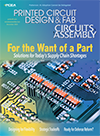News
The companies' experience in soldering technology (both leaded and lead-free) can help industry companies become compliant with the RoHS directives. The seminar is designed to assist companies in transitioning reliably without false starts. The series brings together the information that will save companies many engineering hours of research and will give what is needed to achieve lead-free and RoHS compliancy rapidly.
Topics include: lead-free and RoHS directive overview; impact to a company's operations; impact of dual systems, leaded and lead-free; boards and RoHS requirements; components and RoHS requirements; lead-free soldering and alloy selection; surface finish changes and solderability; equipment changes and process modifications; optimizing the wave solder operation; BGA rework practices; hand soldering and rework production issues; preventing soldering defects with lead-free; contamination controls; training and documentation with lead-free; field service issues with lead-free; and finished assembly identification and traceability.
Lunch and refreshments will be provided. Attendees will receive a lead-free assembly technical manual and detailed white papers; a subscription to the Lead-Free Connection Newsletter; and valuable process information and technical tips to achieve solid lead-free processes.
Created by the JEDEC Board of Directors at the request of industry leaders in flash memory, the committee is focused on standardizing flash memory modules for the industry.
At the meeting, JC64 members will elect a chairman, establish plans for their activities and future meetings, and initiate the standardization work. Mian Quddus from Samsung has been appointed temporary chairman until elections are held.
All interested companies are invited to join.
Irvine, CA-- Henkel Corp. was named a recipient of Intel Corp.'s Preferred Quality Supplier (PQS) award for outstanding performance in supplying Intel with underfill and die attach paste. This is the company's third consecutive PQS award since 2001.
"Henkel has set an example of outstanding customer commitment with flawless support on High Value Manufacturing," said Mark Kaltenbach, Intel Director, Assembly Test Materials Organization. "In addition, Henkel has proven themselves as invaluable technology partner through their dedicated engagement and continuous improvement approach on future technologies with Intel."
Henkel and 25 additional PQS award winners were recognized at a celebration in Burlingame, CA, on March 15. The awards are part of Intel's Supplier Continuous Improvement (SCQI) process that encourages suppliers to strive for excellence and continuous improvement.


